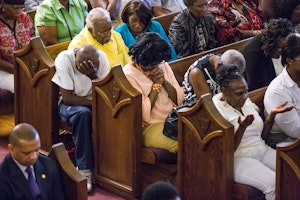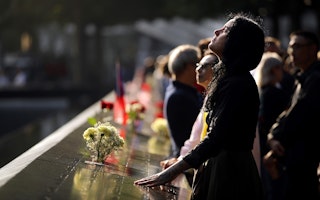The Confederate Flag and the Power of Racial Narrative
By Donysha Smith

After the shooting of nine black parishioners at Emanuel AME Church in South Carolina, the Confederate flag, both a symbol of racism and pride, was removed from the statehouse. But the debate over its place in the racial narrative rages on. Scott Douglas, executive director of Greater Birmingham Ministries, gives historical and cultural context to Confederate symbols, structural racism, and the Southern divide in perception.
What does the Confederate flag mean in the American South? Why is there such a stark racial divide in how people perceive it?
For African Americans in the South, the Confederate flag has always been there, either directly in front of us or right below the level of consciousness. It was always a symbol of terror and discounted freedom, even after all the gains from the civil rights movement.
Flying high at government buildings, it was and is a constant reminder that whatever equality exists today can always be recalled. Black liberty is in a state of constant peril, from the Voting Rights Act to mass incarceration. Your justice can always be taken away. It means terror.
What impact does removing symbols of racism actually have on dismantling structural racism?
The mechanism of symbols is very important. The past is not behind us. Symbols have gravity and power. They galvanize those who would defend a defenseless past.
On the other hand, removing racist symbols, particularly the Confederate flag, can be a galvanizing force in dismantling deeper, structural issues. Future generations of young, white southerners will not grow up with the idea that the Confederate flag flying atop official state buildings is par for the course in civil society. Removing racist symbols, taking the flags down, is a powerful step in dismantling systems that support and encourage white supremacy.
The governor in your home state of Alabama removed the Confederate flag from the capital grounds by an executive order after the killings in South Carolina. Public pressure to remove symbols of the Confederacy have reached a fevered pitch. How can the momentum be sustained and to what end?
There have been multiple calls for national conversations on race and narrative. They tend to be the shortest conversations ever held. What is new is that today, the conversations around racism are not being framed by race “in general” or about “diversity.” The discussions today are grounded in completing conversations that launched, split, and reassembled this nation.
In the aftermath of the murders at Emanuel AME Church, at least half a dozen black churches were burned in the South. What does this mean for black communities of faith?
It means that we have to remain ever vigilant. I was part of a coalition against black church burnings in the 1990s. Burning black houses of worship is not new.
The South is home to over half of all African Americans in the country. We are in the Bible Belt and the Black Belt. These acts are getting coverage now, even though it’s still not being called domestic terrorism in the mainstream media. But it is not new behavior.
Your organization, Greater Birmingham Ministries, is a multifaith, multiracial organization working to advance social justice. What is the place of faith in the racial narrative of the American South and how has it evolved in the post-civil rights era?
Faith has been used by the oppressor and the oppressed. It was used by slave owners to justify holding humans in bondage. Blacks were not allowed to worship with whites … and now we fast-forward to President Obama singing “Amazing Grace” at Clementa Pinckney’s funeral in South Carolina.
Faith in the narrative is the courage of children going to school, integrating lunch counters, facing down the dogs and police batons with fire hoses coming at them with force enough to rip skin and break bones. That is faith. Faith is risking your life repeatedly for a freedom that neither you nor anyone kin to you had ever experienced. Today, there is a strong faith component inherent in the concept of equity that has evolved from Dr. King’s mission for equality.
You are a black man and a parent in the American South. What do you say to those who truly believe, without malice in their hearts, that symbols of the Confederacy are not symbols of hate?
For decent people who are sincere in this belief, there is a line in scripture that says, “If the food you are serving offends, then remove it.” You must summon the empathy to see terror through the eyes of another. If we could only politicize empathy.
Folks focus on intent when it comes to racist symbols; holding onto the idea that as long as I didn’t intend to hurt you, it’s not a bad thing: “It’s my heritage.” My forebears experienced this heritage at the end of a whip, swinging from the gallows, in pain, starvation, and death, while others experienced this heritage as a beautiful antebellum scene with Grandma and sweet tea on the porch.
Know that the Confederate flag is a living symbol of human oppression. And for it to be honored at the highest point of state authority is a condemnation of my existence.
Until December 2018, Donysha Smith was a communications associate for U.S. Programs.


